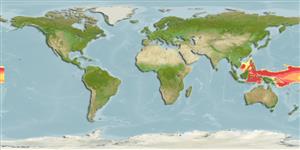>
Eupercaria/misc (Various families in series Eupercaria) >
Callanthiidae (Splendid perches)
Etymology: Grammatonotus: Greek, gramma, atos = signal, mark + Greek, noton = back (Ref. 45335); crosnieri: Probably named for Crosnier..
Environment: milieu / climate zone / depth range / distribution range
पारिस्थितिकी
समुद्री; गहराई सीमा 170 - 210 m (Ref. 9832). Deep-water
Western Central Pacific: known only from the Philippines, off the southwestern coast of Luzon.
आकार / वज़न / Age
Maturity: Lm ? range ? - ? cm
Max length : 12.0 cm SL पुल्लिंग / अलिंग; (Ref. 9832)
Short description
आकृति विज्ञान | मौरफोमैटरिक्स
पृष्ठीय रीढ़ (सम्पूर्ण): 11; पृष्ठीय सौफट रेज़ (सम्पूर्ण): 9; गुदा कांटा 3; ऐनल सौफट रेज़: 9. This species has the following features: D XI, 9; A III, 9; pectoral-fin rays 18-20 (usually 19); pseudobranch with 11-17 filaments; gill rakers 8-9 + 18-20 = 26-29; tubed lateral-line scales 14-17; midbody lateral scales 23-25; circumpeduncular scales 16; scales between anal-fin origin and lateral line 8-9; anal spines are long; in larger specimens, caudal fin with upper and lower lobes well produced (Ref. 111873).
Life cycle and mating behavior
परिपक्व अवधि | पुनरुत्पत्ति | मछलीऔ का अंडे देना | अंडे | Fecundity | लार्वा
Anderson, W.D. Jr., 1999. Callanthiidae. Groppos, goldies, splendid perches. p. 2553-2556. In K.E. Carpenter and V.H. Niem (eds.) FAO species identification guide for fishery purposes. The living marine resources of the Western Central Pacific. Volume 4. Bony fishes part 2 (Mugilidae to Carangidae). FAO, Rome. (Ref. 9832)
IUCN Red List Status (Ref. 130435)
Threat to humans
Harmless
Human uses
अधिक जानकारी
आम नामउपशब्दचपायचयपरभक्षीईकोटोकसीकोलौजीपुनरुत्पत्तिपरिपक्व अवधिमछलीऔ का अंडे देनाSpawning aggregationFecundityअंडेEgg development
Age/Sizeबाढ़Length-weightLength-lengthLength-frequenciesमौरफोमैटरिक्सआकृति विज्ञानलार्वालारवल गतिकीभर्तीबहुतायतBRUVS
संदर्भजलीयकृषिजलीयकृषि रूपरेखाखींचआनुवंशिकीElectrophoresesहैरेटिबिलटीबीमारीप्रक्रमणNutrientsMass conversion
साधन
Special reports
Download XML
इंटरनेट स्रोत
Estimates based on models
Preferred temperature (Ref.
123201): 14.8 - 15.8, mean 15.3 °C (based on 6 cells).
Phylogenetic diversity index (Ref.
82804): PD
50 = 0.5039 [Uniqueness, from 0.5 = low to 2.0 = high].
Bayesian length-weight: a=0.00977 (0.00387 - 0.02465), b=3.08 (2.86 - 3.30), in cm total length, based on LWR estimates for this (Sub)family-body shape (Ref.
93245).
Trophic level (Ref.
69278): 3.3 ±0.4 se; based on size and trophs of closest relatives
Fishing Vulnerability (Ref.
59153): Low vulnerability (10 of 100).
